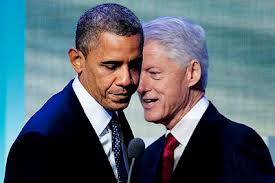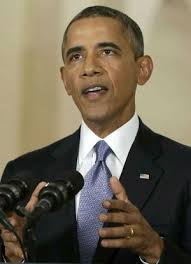Three Cheers for the Shutdown
by NORMAN POLLACK
 Terror Tuesday, where Obama and his National-Security Team pore over hit lists to determine whom, by POTUS’s personal authorization, will be assassinated next, gives way for now to Shutdown Tuesday, the closing of USG, in defiance of the American stock market and the global financial system, lest its effect would be to prevent the raising of the debt ceiling in mid-October and what that portended both for the failure of making payments on Treasury bonds (a default which will, as they say, roil the markets) or for therefore issuing more bonds.
Terror Tuesday, where Obama and his National-Security Team pore over hit lists to determine whom, by POTUS’s personal authorization, will be assassinated next, gives way for now to Shutdown Tuesday, the closing of USG, in defiance of the American stock market and the global financial system, lest its effect would be to prevent the raising of the debt ceiling in mid-October and what that portended both for the failure of making payments on Treasury bonds (a default which will, as they say, roil the markets) or for therefore issuing more bonds.
The “shutdown issue,” presently mired in the political-ideological battle between the Far Right and the Less-Far Right (House Republicans and Administration Democrats), has little to do with the social welfare of the American people, and instead reveals discernible differences only on the degrees of sophistication informing the programs of each in their determined assistance to corporate capitalism. Republicans in this tableau (a staged presentation going back decades in the roles assumed by each side) are the visceral fascists, striking out at government without realizing how much it helps, assists, and protects business and banking, while Democrats actively, yet with becoming liberal rhetoric to hide from themselves their delusions and treachery, take help, assistance, and protection to a higher level of systemic interpenetration between business and government by means of a regulatory framework written by the affected interests.
Let’s put the situation in historical perspective. FDR announced when coming into office that America was a nation one-third ill-housed, ill-clad, ill-fed; today one might say, one-fourth, possibly one-fifth, in a vastly larger population, so that, at minimum, sixty million Americans, in what is reputed to be the richest country in the world, are living, or should I say, existing, at or below the poverty line, and at least a third more barely breaking the surface. When, here, I explicitly call for the government shutdown, it is not to bring on more suffering to the already afflicted, which would follow from a subsequent default, but to clear the air, blow off the fog of false consciousness, and force the issue, especially percolating from below, as to why the distortion of social priorities (x billions to dictators, past, present, future, around the world; y billions to US megabanks and AIG; and z for an all-devouring military machine eating up the nation’s resources which might—dare we speak democratically?—otherwise create a vital social safety net) has been allowed and in various guises pursued for more than half a century.
Shutdown, ideally, equals wake-up, an exposure of widespread impoverishment on one hand, widespread waste, corruption of democratic institutions, and military aggression pure-and-simple on the other. If nothing more, scaring the folks at Morgan Chase and Goldman Sachs until the legislative conflict is papered over, is worth the candle, considering that nothing will be done for the poor in any case.
Sequestration will ensure the lifeblood of the current American polity and economy, militarism attached to the continuing program of global hegemony, so that neither Republicans nor Democrats find urgency in resolving the present stalemate—and in fact, holding the bottom one-fourth of the people hostage to the utter good will of the political system and the consolidated wealth standing behind it, as the source for a solution, is a good lesson in proper obedience, deportment, citizenship. Dangle just enough social- welfare anticipated goodies before the people to ensure quiescence while simultaneously magnifying ideological differences that hardly exist, and one has the perfect formula keeping the masses distracted from the main show—not shutdowns or debt ceilings, but a foreign policy of global capitalist expansion geared to US-defined financial, monetary, and trade advantages, coupled with necessary regime change for their realization, all wrapped in a framework of massive surveillance at home and the quickening paces for demanding patriotism and conformity.
[pullquote]Face-saving measures from either side may avoid a shutdown. So what? Either way, the governing classes are against the people.[/pullquote]
This is not Tea Party fare (and the Republicans as the Partiers’ enablers and breeding ground)—akin to geostrategic dumbness abroad, hoped-for Red Scare forays at home, but rather the self-styled liberals and progressives in their ongoing financialization and militarization of the American economy, monopoly capitalism with a smiley face, comfortably lodged in Democratic ranks. Here government shutdown is welcome, because by giving the political-ideological spectrum a still further Rightward push (Republican intransigence as pretext and excuse for Obama’s failed presidency, except to those privileged by it), the Democrats somehow appear Left-leaning or centrist. Nonsense. Obama has demonstrated on every count subservience not merely to Wealth, but to its most atavistic form: from policies which sanction a rawness of capital accumulation via deregulation, regressive principles of taxation, and subsidies to such favored industries as defense and nuclear power, to social policies which keep working people in a state of suspended animation, their collective bargaining rights weakened, and through lack of job creation, a reservoir of hard-core unemployment resulting in deteriorating standards of living.
On the civil-liberties front, an equal rawness, actuated by the abuses of a saturated counterterrorism atmosphere in which NSA surveillance is a unifying thread for the nuts-and-bolts of a National Security State, from the lack of transparency in government and an over-classification of its documents to the abridgement of freedom of the press in exposing illegal activity and punishment of whistleblowers in Espionage Act prosecutions to the same end. But it is the rawness of military growth and activity under his watch which takes the cake. I have in mind particularly Obama’s pivot to the Pacific, and the encirclement of China, and more immediate, the obvious attention to the Middle East, as part of carving out a future still wider sphere of influence in the region.
Is this off-topic? No, precisely because the threat of a shutdown, whether or not it actually materializes, is like a laser beam into Leviathan’s brain and/or stomach, revealing contents which normal operations of government successfully cover up. Military, yes; public welfare, no. Yet I hope it comes about, in the hope that it energizes the community of the poor to in fact become so, a community discovering itself, now, as the fulfillment of Dr. King’s long-delayed fulfillment of the Poor People’s Campaign, to DEMAND an end to militarism, inequality, inadequate educational opportunities, poor housing—after so many years, a turn-around from FDR’s description of American poverty, and yes, his defiant call to throw the money-changers out of the temple, so ordinarily people can live lives of social decency. The shutdown per se of course would hurt an already hurt to all-intents-and-purposes underclass, but if a permanent change is ever to be effected, a class awakening is of absolute importance.
In that regard, Obama and the Democrats, with their liberalization of corporate class-rule, and what I’ve termed several times the gradual slide into full-scale fascism (surveillance is already a good start, with or without the domestic force-feeding of monopolism and, abroad, aggressive CIA-JSOC paramilitary operations, drone warfare, and main forces still in place, along with the elaborate network of military bases), are a greater obstacle to such class awakening than the heavy-handed, Neanderthalish Republicans who are so easy to spot.
Face-saving measures from either side may avoid a shutdown. So what? Either way, the governing classes are against the people.
My Comment on NYT editorial, “Dawn of a New Era in Health Care,” Sept. 29, relevant here because Republicans have made Obama’s health care plan the issue/pretext for the Shutdown, a plan deeply flawed as herein noted:
The final words of the editorial undercut its overall tone and content: “…that has long been universal in other advanced countries.” NYT praises what deserves opprobrium: private insurers riding the government gravy train, rather than the single payer system which ensures a wider safety net and doesn’t shove money–our money as taxpayers–into the maw of the gorging Private System. Indeed,those final words are incorrect in one important respect: “other advanced nations.” For the US plan places America in the political-structural context of being a DECLINING not an advanced nation. We have sacrificed the people’s health on the altar of ideology: market fundamentalism, the natural-rights status of private property, profit before moral decency. Obama = the liberalization of a militarized capitalism, rhetoric glossing over reality.
Norman Pollack is the author of “The Populist Response to Industrial America” (Harvard) and “The Just Polity” (Illinois), Guggenheim Fellow, and professor of history emeritus, Michigan State University. His new book, Eichmann on the Potomac, will be published by CounterPunch in the fall of 2013.
Nauseated by the
vile corporate media?
Had enough of their lies, escapism,
omissions and relentless manipulation?
Send a donation to
The Greanville Post–or
But be sure to support YOUR media.
If you don’t, who will?






